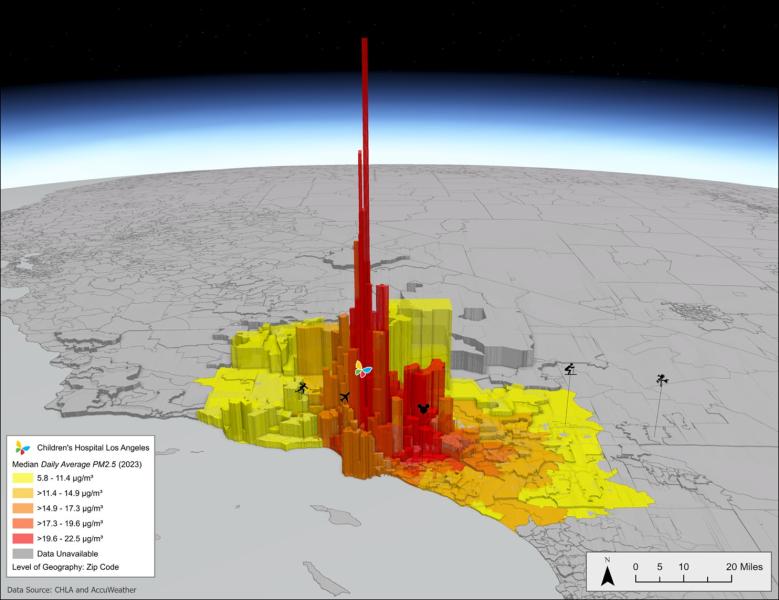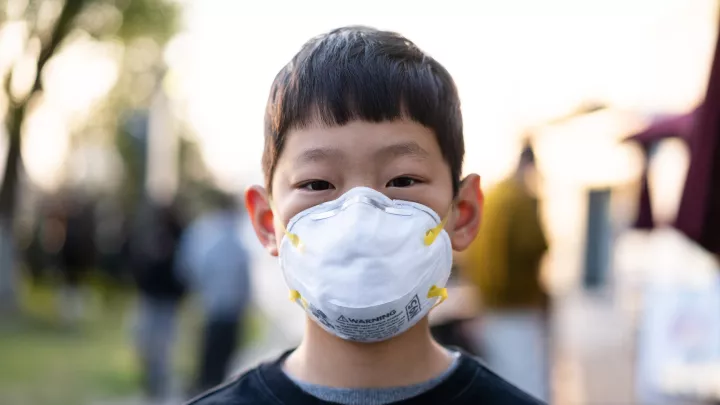
CHLA’s Dr. Jonathan M. Tan (right, standing) presents his work at a technology and artificial intelligence meeting in San Francisco in early 2024, showcasing the platform that integrates CHLA’s electronic health records with AccuWeather’s air quality data.
A Brighter Forecast: How a CHLA Anesthesiologist and AccuWeather are Using Environmental Data to Transform Children’s Health Care
For pediatric anesthesiologist Jonathan M Tan, MD, MPH, MBI, FASA, making an impact in pediatric health care started with a single question: With children being among the most vulnerable to the effects of weather and climate change, why are health care professionals and health systems not equipped with the environmental exposure data needed to protect their patients’ health?
“Answering this question and working toward a solution led me on an exciting journey to solve an unmet need in pediatric health care,” Dr. Tan explains. He seized the opportunity to pursue connecting patients’ electronic health records with weather and climate data. This integration is unlocking powerful insights into how environmental factors directly impact children’s health and is enabling health care professionals, researchers, and advocacy experts to make more informed decisions.
This all started when Dr. Tan, now the Vice Chair of Analytics and Clinical Effectiveness in Anesthesiology Critical Care Medicine at CHLA, noticed the link between where his patients lived and how they were more likely to be diagnosed with respiratory diseases like asthma. He also realized that some patients without a respiratory disease would sometimes be at higher risk for respiratory complications when receiving anesthesia. “I have had the privilege of caring for patients at four of the top U.S. children’s hospitals,” he says. “When I was getting to know a new city and learning where patients were traveling from to receive care, I would see first-hand that air quality and exposure to poor environmental conditions were key factors in children’s health.”
Dr. Tan realized that health professionals would be better able to care for their patients if they had access to information on each patient’s home environment and air quality in their area. “This is not a part of patients’ medical records today, so it can be challenging to counsel patients adequately, prescribe the right prevention-focused treatment plans, and conduct large-scale research on environmental exposures on children,” he explains.
Jonathan M Tan, MD, MPH, MBI, FASAWhen I was getting to know a new city and learning where patients were traveling from to receive care, I would see first-hand that air quality and exposure to poor environmental conditions were key factors in children’s health.
Dr. Tan also learned that existing research analyzing the impacts of the environment on children’s health was limited. Studies often had small population sizes or did not incorporate key details. Dr. Tan saw that he was uniquely positioned to solve this problem.
At the center of the Venn diagram
“My background spans public health policy, clinical medicine, and informatics and analytics,” Dr. Tan explains. “Where those areas intersect on a Venn diagram is exactly where this work takes place.”
Dr. Tan has a master’s degree in public health and another in clinical informatics. As a a national leader in pediatric anesthesiology, he cares for patients in every area of the hospital where they require sedation and general anesthesia for procedures. He appreciates the responsibility of delivering safe, effective and equitable care to children during some of the hardest times of their life. And as the Vice Chair of Analytics and Clinical Effectiveness in his department, Dr. Tan is responsible for advancing patient safety and quality improvement initiatives.
Before coming to CHLA, Dr. Tan started to explore strategies to integrate environmental data into medical records. To start making his vision a reality, he would need to bring together environmental experts, clinical and public health professionals, clinical informaticists, and spatial scientists.
“When I was getting started, I would cold call and email leaders in different fields,” Dr. Tan says. “For example, I saw a TED Talk delivered by the CEO and co-founder of Plume Labs, an organization focused on making air quality information accessible and empowering. I emailed them and described my vision.” Dr. Tan ended up presenting to a team from Plume Labs on what it would look like to incorporate their air quality data into electronic health records at a children’s hospital, and they came on board. He continued to seek out additional experts to move the work forward.
“I traveled around the world to different conferences to learn about the various techniques that would enable us to build our interdisciplinary work,” Dr. Tan explains. This work was part of what ultimately brought him to CHLA in 2020.
Los Angeles: A natural laboratory
“Los Angeles is a great place to study differences in the environment and particularly air quality,” Dr. Tan says. “Due to the microclimates that exist here and the diversity in our patient population, it’s a natural lab.” Dr. Tan’s faculty affiliation with the University of Southern California (USC) was also a draw to L.A. “I’m a faculty member with the Spatial Sciences Institute at USC, which has a mission to turn geospatial data into solutions for a healthy and safe world. The Institute is among the best in the country in this area, and I’m incredibly thankful for the support of its Founding Director, Professor John P. Wilson.”

At CHLA, Dr. Tan built a team consisting of PhD candidate Andrew Kampfschulte and geospatial analyst Alicia Adiwidjaja. Plume Labs was eventually acquired by AccuWeather, a leading weather forecasting organization that is the world’s most used source of weather forecasts and warnings. Collaborating with a larger team of experts, particularly Tyler Knowlton, Director of Communications, Communities, and Partnerships and leader of the Climate Impact Program at AccuWeather, has enabled Dr. Tan and his team at CHLA to accelerate their work.
“We’re now accessing a wide array of weather and climate data from AccuWeather,” Dr. Tan says. “This includes temperature, precipitation, humidity, ultraviolet exposure, and air quality, which is broken down into measurements of particulate matter in the air.” It is important to study particulate matter of different sizes, as smaller particles can penetrate deeper into the body when a person breathes in. Some are small enough to get into the lower airways and even the bloodstream. These particulates can affect a child’s ability to breathe.
“Our unique partnership with AccuWeather enables us to link their weather and climate data to our patients’ home locations in a HIPAA-compliant manner to pinpoint our patients’ exposures and their health status,” Dr. Tan says. “Then we combine all this information across our entire health system population. This allows us to create models of risk, as well as eye-opening maps showing the environments in which our patients are living.” The results have been enlightening.
Jonathan M Tan, MD, MPH, MBI, FASAWe’re now accessing a wide array of weather and climate data from AccuWeather. This includes temperature, precipitation, humidity, ultraviolet exposure, and air quality, which is broken down into measurements of particulate matter in the air.
“Of course, in downtown L.A. and near highways, air quality is poor due to emissions from cars and trucks,” Dr. Tan explains. “But a lot of our patients come from areas with less traffic, and many of them still have asthma-related health problems,” Dr. Tan explains. “It turns out that in those areas, the poor-quality air can be stagnant, and the wind doesn’t clear it out like it does closer to the coast—it's a microclimate.” This leads to a higher concentration of harmful particulates in the air that can affect children.
New data brings new discoveries
Dr. Tan and his team have linked weather and climate data for over 300,000 patients seen at CHLA over the last 5 years, building a detailed understanding of each patient’s environmental exposures. The team has developed a 3D map that allows someone to move through the Southern California region and track the air quality in each area. “This technology is exciting because it allows us for the first time to study the health outcomes of patients across an entire pediatric health system based on their environmental exposures,” Dr. Tan says. “This unlocks our ability to better understand disparities in exposures and health, and to find opportunities to intervene and reduce environmental risks for children.”

The information that Dr. Tan and his team have compiled has already revealed new facts. For example, more than half of CHLA’s patients live in areas with air quality that is above the World Health Organization’s recommended limit. And in terms of environmental exposure disparities across CHLA, some children experience 2-4 times more exposure to poor air quality than others.
“Air quality is related to where kids live, and where kids live depend on a variety of factors, including their socioeconomic status,” Dr. Tan explains. “Families that live in areas of the city with a lower socioeconomic status are more likely to be exposed to worse air quality.”
Dr. Tan’s collaboration with AccuWeather’s experts has also allowed his team to focus on another important factor: climate change.
“Climate change is putting our children’s health at risk,” Dr. Tan explains. “Children are especially vulnerable to heat-related illnesses, rising air pollution, wildfires, food and water insecurity, the spread of infectious diseases into new geographic areas, and the mental health challenges that come with climate disasters and displacement."
A grand plan for researchers, clinicians, and health systems
Dr. Tan sees the strategic partnerships he is building as part of a grand plan to enable researchers, clinicians, and health systems to be better equipped for the environmental health impact of weather and climate on children. “We’re building a strong foundation of partners to scale our innovative work to the rest of the country and make the leap from describing problems to prescribing solutions,” he says.
“We’re not far away from that now. The forecast is looking good.”


